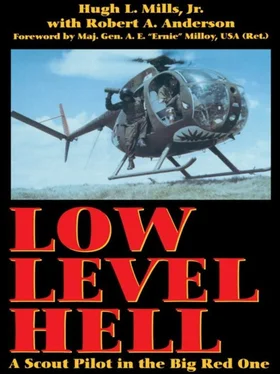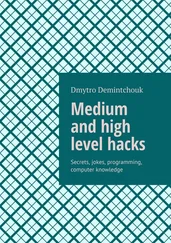I jerked my head around and looked back. Damn. Parker’s grenade had dropped in the stream and gone out.
We were catching it from below, taking hit after hit in the aircraft. But there was nothing left to do but pull around and make another run over the stream to put down a good mark for Sidewinder.
This time Parker dropped two grenades to avoid a repeat of the problem. He let the spoons fly and both grenades popped in his hands before he dropped them. Parker’s gloves protected his hands as the smoke poured from the ports at the bottom of the canister. Red smoke billowed up at us as we hightailed it back toward the ARP’s position.
We stayed down as low as we could, fairly brushing the treetops. I felt myself sucking down into the armor plate and tried to keep my pucker factor from totally eating the seat cushion.
Sidewinder’s voice popped back into my phones. “OK, Darkhorse, we’ve got your marker. Get yourself clear. We’re inbound with high-drag snake and nape.”
As I pulled back in over the ARPs, the whole northern area exploded into great balls of black smoke and fire. Sidewinder’s fast movers had just hung a detour sign on Charlie’s back door escape route.
Through the roar of explosions I suddenly heard the troop commander’s voice over VHF, advising us that he was overhead in his command Huey, and that we’d soon have a supporting infantry company on the scene. The plan was to put about 150 troops on the ground, on the backside of the ARPs, engage the enemy soldiers that had flanked the ARP position, then drive the bad guys back toward their base camp.
About eight minutes later a flight of ten Hueys flew in. They descended below the tree line to my north, then took off again, apparently heading back to Dau Tieng for another load of friendlies.
Moments later, the Cobra broke in on FM. “OK, Four Six, get your heads down. Inserted unit reports fifty to seventy-five, possibly one hundred enemy troops coming your way. They have engaged and turned them around. They’re now headed back toward your position on the way into their base area. They’re comin’ fast!”
I could tell that Harrell had read the Cobra’s warning. He was crawling around to his men, checking their ammo and trying to get them better positioned to fight off the next onslaught.
The jungle below me literally exploded again with heavy firing. As predicted, the enemy soldiers were rushing back down the tank bust
in full retreat, apparently determined to take down everything that stood in their way.
The ARPs opened up with blistering fire. The enemy surged ahead, The battle became head-to-head and nearly hand-to-hand before the surge of oncoming soldiers veered off the trail to the east, trying to bypass the merciless fire of Harrell’s aeroriflemen.
Their move off to Four Six’s flank gave me the room I needed to shoot. I dropped down to a hover over Harrell, dumped the nose, and took aim over the heads of the ARPs, pulling the minigun trigger back to the four-thousand-rounds-a-minute stop. Kicking left and right pedals, I hosed out everything I had into the tree line. Parker was leaning out of the right side, spraying down the running enemy soldiers with 7.62.
I suddenly went dry on the minigun. Parker, just seconds later, went dry on the M-60. We had thrown everything we had at them, except for Parker’s backup. In desperation, he reached back for his “Thumper” and started pumping out M-79 40mm rounds, followed by a full thirty-round magazine out of his “stowed for last resort” M-16.
As abruptly as the furor had started, it ended. There was almost dead silence, except for the whirring sound of my rotors.
I maneuvered back over the ARP’s position, about twenty feet off the ground, and looked down at Harrell. He was sitting on the ground, still without his steel helmet, legs stretched out in front of him. His bleeding, grimy left arm was cradled in his lap and his jungle fatigues were black with sweat. The bolt of his still-smoking CAR-15 was in the open position, indicating that he had expended his last round and was on an empty ammo magazine.
I could hardly tell if he was dead or alive, until he finally turned his sweat-drenched face up toward me. Through his pain and exhaustion, he managed a grin.
As I smiled and waved back, he reached over to his RTO and picked up his radio mike. He looked back up at me and flashed another big, toothy grin. “Goddamnit, One Six, I think we won!”
Intelligence gathered from the scene, and from the enemy bodies found in the killing zone after that free-for-all on the tank bust trail, told us several remarkable things. Among them was an explanation of the explosion under Willis’s ship, which had started the whole fracas in the first place.
As One Seven suspected, it wasn’t a glancing RPG round that had been fired at his aircraft. It was, rather, clever use of a CHICOM mine, the enemy’s answer to our Claymore antipersonnel mine. These mines looked like big black metal frying pans and were filled with military plastic explosive and metal fragments. The enemy soldiers had jury-rigged one of them in the top branches of a tree, right in the center of their newly constructed, heavily fortified, and well-concealed base camp area. Their idea was that when an aeroscout hovered over the tree trying to look down through the jungle to find an enemy base camp, they’d blow the mine by remote control and get themselves a U.S. chopper.
They almost did. They did succeed in giving Rod’s aircraft a hell of a jolt, plus wounding Joe Cook in the hand with one of the mine fragments.
Papers found on enemy bodies told us something else—something that, even in light of all the casualties taken by the ARPs, was damned happy news for the 1st Division. The newly established enemy base camp belonged to none other than the infamous Dong Nai Regiment—the tough, elusive, hard-core NVA regulars we had been trying to pin down for months.
It was determined to be an enemy force of between one hundred fifty and two hundred troops. On that particular day, they had run up against twenty-eight men of the aerorifle platoon, and had gotten their noses bloodied in the process.
The ARPs had been outnumbered ten to one, and had it not been for the tenacity they exhibited that day, like so many other times before in the field, the Dong Nai would have gone through them “like crap through a goose,” as General Patton supposedly said during World War II. The ARP casualties were extremely heavy, and came right on the heels of their terrible losses in the Huey LZ mine incident just days before. But these twenty-eight men, with an effective fighting force of only about twenty, prevailed against the toughest regular North Vietnamese Army outfit we knew about.
The 1st Division was anxious to deliver the coup de grace. We had hurt the Dong Nai badly up on the tank bust trail, but they were still a viable force. We wanted to put them out of commission for good.
Hoping to catch the rest of the regiment at home in their bunkers, division set up an Arc Light to hit a suspected jungle base area just south of the Michelin. The target for the B-52 strike was a grid “box” on the ground, two kilometers wide by five and a half kilometers long. We knew that this area contained a number of bunkers, connecting trenches, antiaircraft machine guns, and—we hoped—the remnants of the Dong Nai.
The “Big Belly” B-52 Stratofortresses were equipped with multiple ejector racks capable of carrying up to forty-two iron bombs, each weighing 750 pounds. The airplanes were to fly in from their base in Guam, unload their explosives into our designated box of eleven square kilometers, then head back home.
We had a hunter-killer team waiting at FSB Kien to do a BDA of the area just as soon as the B-52s finished their business. I was the designated scout, Parker was my Charlie Echo, and Bruce Foster was my gun.
Читать дальше












